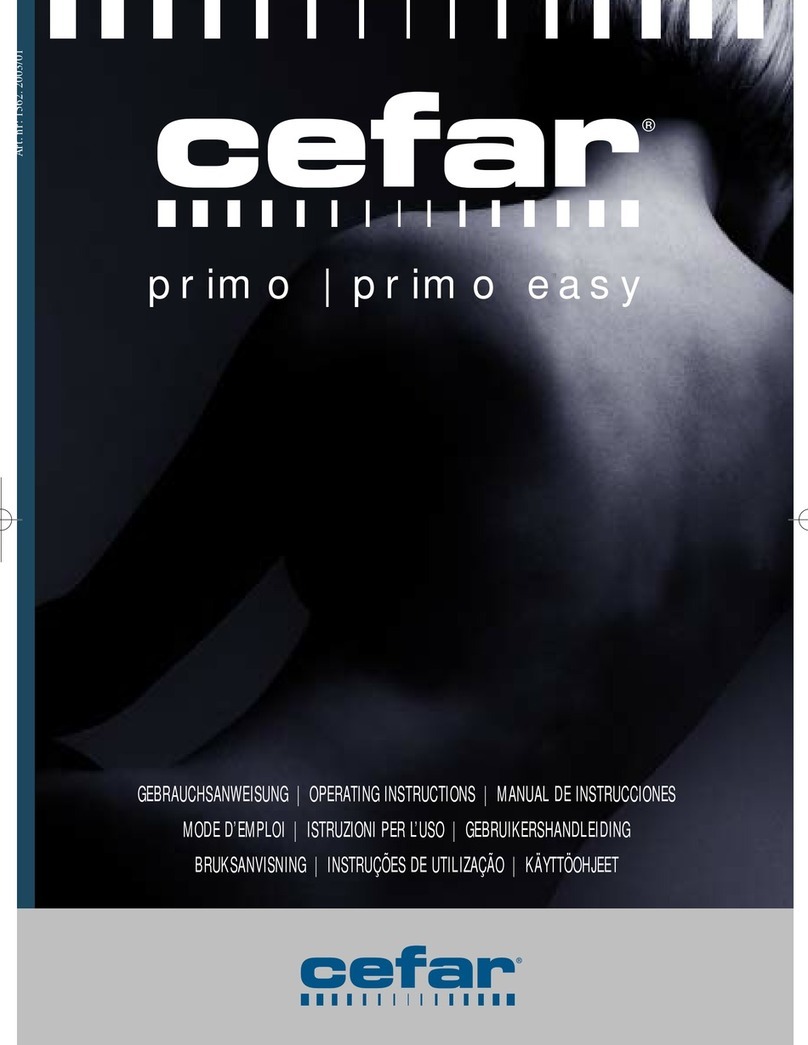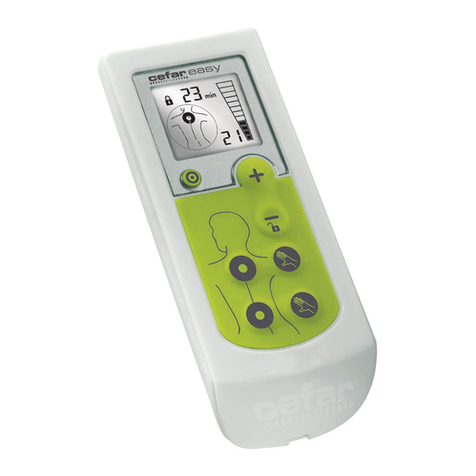
. PRECAUTIONARY MEASURES
.. CONTRAINDICATIONS
• Implanted electronic devices. Do not use the device on patients who have a cardiac pacemaker, implanted defi-
brillator, or other implanted electronic device, because this may cause electric shock, burns, electrical interference,
or death.
• TENS for Undiagnosed Pain. Do not use the device as a TENS device on patients whose pain syndromes are
undiagnosed.
.. WARNINGS
• Consult with physician. Consult with the patient’s physician before using the device, because the device may cause
lethal rhythm disturbances to the heart in susceptible individuals.
• Skin condition. Apply stimulation only to normal, intact, clean, healthy skin.
• Long term effects. The long-term effects of chronic electrical stimulation are unknown.
• Stimulation location. Stimulation over Neck or Mouth. Do not apply stimulation over the patient’s neck (especially
the carotid sinus) or the patient’s mouth, because this could cause severe muscle spasms resulting in closure of
the airway, difficulty in breathing, or adverse effects on heart rhythm or blood pressure.
• Stimulation across Chest. Do not apply stimulation across the patient’s chest, because the introduction of electri-
cal current into the chest may cause rhythm disturbances to the patient’s heart, which could be lethal.
• Across the head. Since the effects of stimulation of the brain are unknown, stimulation should not be applied
across the head, and electrodes should not be placed on opposite sides of the head.
• Stimulation over compromised skin. Do not apply stimulation over open wounds or rashes, or over swollen, red,
infected, or inflamed areas or skin eruptions (e.g., phlebitis, thrombophlebitis, varicose veins).
• Stimulation near cancerous lesions. Do not apply stimulation over, or in proximity to, cancerous lesions.
• Stimulation over eyes. Do not apply stimulation directly on the eyes.
• Environment. Electronic monitoring equipment. Do not apply stimulation in the presence of electronic monitoring
equipment (e.g., cardiac monitors, ECG alarms), which may not operate properly when the electrical stimulation
device is in use.
• Bath or Shower. Do not apply stimulation when the patient is in the bath or shower. Do not apply stimulation in
humid atmosphere exceeding % of relative humidity.
• Sleeping. Do not apply stimulation while the patient is sleeping.
• Driving or operating machinery. Do not apply stimulation while the patient is driving, operating machinery, or
during any activity in which electrical stimulation or involuntary muscle contraction can put the patient at risk
of injury.
• Electrosurgical equipment or defibrillators. Disconnect the stimulation electrodes before using electrosurgical
equipment or defibrillators. Otherwise skin burns may be caused below the electrodes and the device might be
destroyed.
• Magnetic Resonance Imaging. Do not wear electrode or the device during Magnetic Resonance Imaging (MRI)
scans as this may result in metal overheating and causing skin burns in the area of the electrode.
• Flammable or explosive environment. Do not use the device in areas where there is a risk of fire or explosion, such
as oxygen-rich environments, in the vicinity of flammable anaesthetics, etc.
• Power supply. Never connect stimulation cables to an external power supply as there is a risk of electric shock.
• Near other equipment. Do not use the device beside or stacked on top of any other equipment. If you must use
it side by side or on top of another system, you should check that the device works properly in the chosen con-
figuration.































